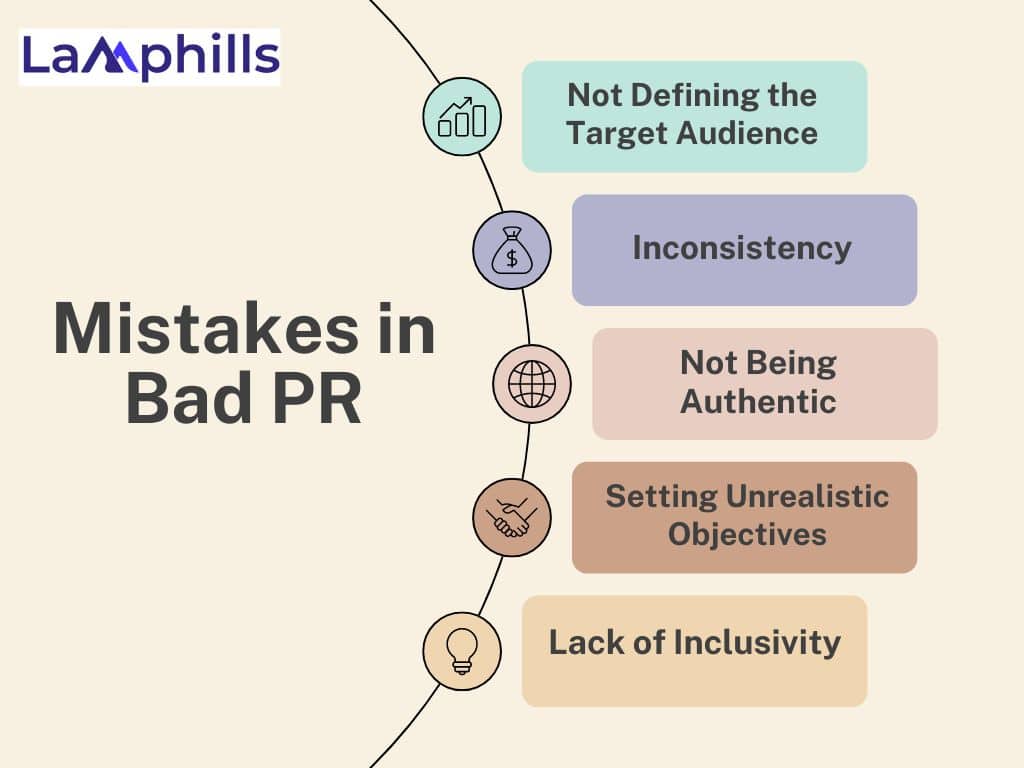One Bad PR can damage a company’s reputation a lot. Even the biggest brands can mess up so badly that it costs them millions of dollars. I’ll always remember the day I truly understood the impact of public relations. One early morning, I was having my usual coffee and reading the news when I saw an alert about a major tech company’s PR disaster.
The CEO had made an insensitive comment during a live interview, sparking outrage on social media. Watching the situation unfold, I knew I was seeing a perfect example of bad PR. This event highlighted the importance of careful communication and reinforced the lessons I had learned in my career as an HR consultant and content writer. Today, I want to share some of these lessons with you, based on my experiences and notable PR mistakes.
Read Also: How Bad Communication Costs Your Business & How to Fix It in 7 Steps
Key Points
- PR is essential for success, especially in publicly traded companies where share value depends on public trust.
- Bad PR results from poor planning and execution. When a PR campaign fails, it can damage a company’s reputation.
- Some common mistakes in bad PR include: Not defining the target audience, Setting unrealistic objectives, Using boring or uninformative content, Lacking an effective distribution plan, and Not monitoring or evaluating the campaign
- To properly handle a negative PR, companies should be aware of common causes of negative PR. While these can vary by industry, some issues like poor-quality press coverage, negative reviews, and customer complaints are widespread. Recognizing these early can help stop problems from escalating.
What is Public Relations (PR)
Public relations (PR) involves managing how information about a person or company is shared with the public and the media. The main goals are to share important news, maintain a good brand image, and manage negative events to reduce their impact. PR activities include press releases, news conferences, interviews, and social media posts.
It is essential for success, especially in publicly traded companies where share value depends on public trust. PR handles media requests, information queries, and shareholder concerns, and manages the company’s image. Sometimes, PR professionals may try to damage a competitor’s reputation, although this is against industry ethics.
There are various aspects of Public relations. Let’s find out.
Types of Public Relations
Public relations is often divided into different areas, each focusing on a specific aspect:
Media Relations: Building strong relationships with media and organizations. This team delivers company news, provides reliable content, and is available for public comments on other news stories.
Production Relations: Supporting the company’s operations, especially during major events like product launches, special campaigns, or significant product changes.
Investor Relations: Managing the relationship between the company and its investors. This includes organizing investor events, communicating financial reports, and addressing investor complaints.
Internal Relations: Focusing on the relationship between the company and its employees. This involves counseling employees, ensuring job satisfaction, and resolving internal issues to prevent public dissatisfaction.
Government Relations: Connecting the company with government bodies. This department provides feedback to politicians, influences decision-makers, and ensures fair treatment for the company’s clients.
Community Relations: Enhancing the company’s reputation within a specific community, whether physical (like a city) or non-physical (like a group of dog owners). This branch aligns the company with the community’s social niche.
Customer Relations: Bridging the gap between the company and its customers. This involves managing key relationships, conducting market research, understanding customer priorities, and addressing major concerns.
It’s either your PR campaign succeeds or fails. A good or Bad PR is decided from the campaign outcome. Let’s see a better explanation.
Good Public Relations
A successful PR campaign is well-planned and executed with clear goals. Objectives should be defined from the start, and strategies should align with these goals. The campaign needs regular monitoring and evaluation to ensure it stays on track and achieves the desired results.
Key elements of a good PR campaign include:
- Understanding the target audience
- Setting realistic objectives
- Creating a well-structured PR plan
- Producing well-written and engaging content
- Having an effective distribution plan
- Allocating a realistic budget
- Monitoring and evaluating regularly
- Being prepared for any crisis
Now, let’s see what makes a Bad PR.
Bad Public Relations
Bad PR results from poor planning and execution. When a PR campaign fails, it can damage a company’s reputation.
Common mistakes in bad PR include:
- Not defining the target audience
- Setting unrealistic objectives
- Lack of Personalization
- Inconsistency
- Ignoring Local Media
- Not Being Authentic
- Lack of Inclusivity
- Failing to Deliver on Promises

#1. Not Knowing Your Audience
It’s easy to get excited about promoting your new product or service. However, your PR campaign might fail if you don’t know your target audience. Before starting, ask:
- Who is your target audience?
- Why are you launching the campaign?
- When is the best time to do it?
- Which media outlets should you contact?
- How will you use social media to expand your reach?
Ignoring these questions can waste resources and harm your company’s success.
#2. Lack of Personalization
Even with a clear target audience, not everyone has the same needs. Customize your PR efforts for each individual. For example, personalize emails when inviting media to events. Show genuine interest by mentioning something specific about them. The more personal your approach, the better your chances of getting noticed.
#3. Inconsistency
Being visible only when promoting something new is not enough. Consistent PR efforts keep your company in consumers’ minds, build trust, and reinforce brand loyalty. Regular PR campaigns, aligned across different departments, ensure a cohesive message and strengthen your market presence.
#4. Ignoring Local Media
While national media coverage is beneficial, it can be hard to secure for small businesses. Focus on local media first to build an audience and improve your PR strategy. Success with local outlets can lead to attention from larger media.
#5. Not Being Authentic
Staying updated on trends is important, but following every trend can harm your brand. Ensure that any trend you capitalize on aligns with your company’s mission and values. Staying true to your brand prevents it from blending in with others.
#6. Lack of Inclusivity
Your audience is diverse, and your PR campaigns should reflect that. Avoid campaigns that inspire negativity or prejudice. Promote inclusivity and diversity in your products and marketing to show your company’s values.
#7. Failing to Deliver on Promises
Not meeting expectations can drive customers away. If your product or service doesn’t live up to the PR hype, have a strong customer service team ready to fix issues. Failing to deliver and not addressing problems can severely limit your business’s future.
Avoid these PR mistakes to enhance your company’s reputation and success.
Bad PR is the opposite of what PR should be. It shows that the company’s marketing strategy is missing a plan, procedure, or goal. Here are some examples of a Bad PR.
Bad PR Examples & Lessons You Should Learn
#1. The Pepsi Kendall Jenner Ad
I chose this to be the first example because is one of the worst PR disasters. The ad intended to promote unity but ended up underplaying important social justice movements. The backlash was immediate and intense.
In 2017, Pepsi launched a campaign featuring Kendall Jenner, showing young people protesting peacefully while Jenner was filming a photo shoot nearby.
Jenner had an “enlightenment” moment, stopped the shoot, joined the protest, and handed a can of Pepsi to a police officer, making the crowd cheer.
The ad aired soon after major protests against racial inequality and police brutality in the USA, which were part of the significant Black Lives Matter movement.
Pepsi aimed to acknowledge the protests and the movement, but the public saw the ad as insensitive and a cheap promotion tactic exploiting serious social issues.
Pepsi apologized and pulled the campaign. This incident highlights why it’s unwise to mix product promotion with serious social issues. If you want to support a movement, do it without using it for marketing.
Lesson Learned: Always know your audience. Early in my career, I launched a campaign that didn’t connect with our target audience. This taught me to always research and understand my audience before starting any campaign.
#2. #DeleteUber Campaign

In January 2017, customers became angry with Uber when the company tried to take advantage of a New York taxi strike. Uber said it wanted to support the striking drivers, but when it lowered prices for JFK pickups, many users thought Uber was trying to undermine the strike. The hashtag #DeleteUber quickly went viral, and people began deleting the app in large numbers.
The backlash grew because of existing complaints about Uber’s treatment of drivers and toxic corporate culture. As a result, many users deleted the app, hurting Uber’s reputation.
Lesson Learned: The key lesson from the #DeleteUber incident is clear: if your company wants to support a strike or protest, make sure your actions are genuine and not aimed at making a profit. Businesses need to match their actions with public opinion and social issues. Trying to make money during sensitive times can lead to backlash. Companies should truly support social movements instead of using them for marketing. Being honest and ethical is key to keeping trust and a good reputation. Also, fixing internal problems, like how employees are treated, is essential for long-term success and public approval.
#3. Dolce & Gabbana Chinese Ad
Dolce & Gabbana is another brand well-known for bad PR incidents. The most notable scandal in recent years happened after the release of a commercial in Shanghai. The ad showed a Chinese model struggling to eat Italian pizza, spaghetti, and cannoli with chopsticks while an off-screen male voice gave instructions. Many people found the video offensive, saying it had clear racist and sexist undertones.
The Chinese fashion show promoted in this commercial was canceled. In response, Stefano Gabbana insulted China, calling it the “Ignorant Dirty Smelling Mafia,” but later claimed his Instagram was hacked. As a result, major Chinese online retailers stopped selling the brand’s items, and the video was removed from all channels.
Only after this did Dolce & Gabbana apologize, saying they loved China and its culture.
Three years later, the luxury fashion brand is still suffering from the fallout of the controversial ad. China was a major market for Dolce & Gabbana, and losing it was a financial disaster.
Lesson Learned: The Dolce & Gabbana Chinese ad controversy shows the importance of cultural sensitivity and respect. Brands need to fully understand and respect the cultures they work with to avoid offending them. If mistakes happen, quick and sincere apologies are essential. Losing the trust of a big market can hurt financially for a long time. Being proactive about cultural awareness can prevent harmful PR issues.
#4 Tesla Cybertruck Demo Failure
In 2019, Tesla showcased its new bulletproof Cybertruck, heavily promoted by founder Elon Musk. However, during the live presentation, the vehicle’s “armor glass” failed twice when hit with metal balls, shattering instead of withstanding the impact.
Elon Musk later explained on Twitter that before the demonstration, Tesla’s main designer, Franz von Holzhausen, had hit the truck’s door with a sledgehammer to show its strength. This might have weakened the glass, causing it to break during the live test.
PR experts suggested that the demo might have been a stunt to attract media attention, but Tesla’s stock still dropped by more than 6% after the event. The lesson here is clear: always thoroughly test your product before promoting its features.
Lesson Learned: The Tesla Cybertruck demo failure shows that live demos are risky and can go wrong if not fully tested. When Elon Musk showed the Cybertruck’s “unbreakable” windows, they broke during the event, causing embarrassment and ridicule. This incident stresses the importance of making sure every part of a product works before showing it to the public. It also highlights the need for good damage control and quick, honest responses to failures. Finally, it reminds companies that even top brands can face bad publicity if they don’t meet public expectations during big launches.
#5. United Airlines Dragging Incident
The United Airlines dragging incident is a well-known example of bad public relations. In April 2017, United Airlines needed to make room for four employees on a fully booked flight from Chicago to Louisville. The airline asked for volunteers to give up their seats in exchange for compensation. When not enough people volunteered, they randomly selected passengers to leave the plane. One of these passengers, Dr. David Dao, refused to give up his seat because he needed to get home to see patients.
United called security officers, who forcibly removed Dr. Dao from his seat and dragged him off the plane. Other passengers recorded the incident, showing Dr. Dao being pulled down the aisle with a bloodied face. These videos quickly went viral on social media, causing widespread outrage and condemnation of United Airlines.
The incident damaged United Airlines’ reputation, leading to a drop in its stock price and long-term harm to its brand image. It highlights the importance of good customer service, effective crisis management, and the potential consequences of mishandling PR situations.
Lesson Learned: The United Airlines dragging incident teaches us the need to prioritize customer service and respect passengers. Handling crises well is vital to avoid public anger. Poor PR management can severely damage a company’s reputation and cause financial losses. Companies should have clear policies and well-trained staff for unexpected events. Also, in the social media age, negative events can quickly spread, making their impact much worse.
#6. Susan G. Komen and Planned Parenthood

Susan G. Komen, a well-known breast cancer organization, faced strong criticism in 2012 when it chose to stop funding breast cancer screenings at Planned Parenthood. People saw this move as politically driven, causing widespread anger and backlash from the public and Komen’s supporters. This controversy led to a major drop in donations and hurt Komen’s reputation. The organization later reversed its decision and resumed funding Planned Parenthood, but the incident left a lasting negative impact on its public image.
Lesson Learned: The controversy between Susan G. Komen and Planned Parenthood shows that organizations need to think about the possible backlash from politically sensitive decisions. Such actions can greatly impact public support and donations. Being open and sticking to the organization’s main mission is key to keeping public trust. Quick and clear communication is important to address public concerns and reduce harm. Finally, even if an organization reverses a controversial decision, it might not completely fix its reputation.
#7. BP’s Response to the Gulf Oil Spill
BP’s handling of the 2010 Gulf Oil Spill is a classic example of poor public relations. BP was slow and ineffective in managing the disaster, initially failing to grasp its seriousness. The CEO’s insensitive comments, like wanting his life back, angered the public. Their efforts to deflect blame and their poor communication made the situation worse. This incident greatly damaged BP’s reputation and showed the need for quick, empathetic, and clear communication in a crisis.
Lesson Learned: The main lesson from BP’s response to the Gulf Oil Spill is the need for quick and effective crisis management. Companies must act fast and seriously in a disaster to reduce harm. Leaders should speak with empathy and avoid insensitive comments. Honest and clear communication is crucial for keeping public trust. How a company manages a crisis greatly affects its reputation.
Communicate clearly and with compassion. During a crisis at a former workplace, our CEO’s empathetic and transparent communication helped calm the situation and retain client trust. It’s essential to communicate with empathy and clarity, especially during a crisis.
#8. EasyJet and Broken Seats
Twitter can significantly damage a brand’s reputation. EasyJet experienced this in 2019 when a passenger, Matthew Harris, tweeted a photo of an older woman sitting on a backless seat on an EasyJet plane. He tagged the company to highlight the issue.
Journalists picked up the story, prompting an unclear response from EasyJet. The airline asked Harris to remove the tweet and discuss the matter privately, which led to even more online criticism. Later, an EasyJet representative clarified that no passengers were allowed to sit on backless seats, emphasizing, “Safety is our top priority. EasyJet follows all safety rules.”
The issue wasn’t just about the backless seat. Other airlines faced similar problems without such a scandal. EasyJet’s request to delete the image made customers think the company was hiding something.
Lesson Learned: The EasyJet broken seat incident shows that keeping customers happy is key to a good brand image. Clear communication is vital when fixing service problems to avoid confusion and bad publicity. Quickly addressing customer complaints can stop small issues from becoming major PR problems. Regularly checking and maintaining service quality can prevent these incidents. Finally, being open and responsible when dealing with customer issues can rebuild trust and credibility.
#9. Fyre Festival

The Fyre Festival is a great example of bad PR. Advertised as a high-end music festival on a private island, it ended up being a disaster. Attendees arrived to find poor accommodations, bad food, and no promised entertainment. The organizers didn’t communicate the problems and kept misleading the public. This caused a lot of anger on social media, lawsuits, and criminal charges against the founder. The Fyre Festival fiasco shows why honesty, good planning, and transparency are crucial for a good public image.
Lesson Learned: From the Fyre Festival disaster, we learn that honesty in advertising is vital. To keep customers’ trust, promises must be kept. Proper planning and logistics are crucial for a successful event. Communicating well with attendees is important, especially if issues occur. Lastly, being open and accountable helps prevent public backlash and legal troubles.
Don’t overpromise. I remember in one PR campaign, we promised more than we could deliver, leading to disappointed clients and damaged relationships. It’s better to set realistic expectations and exceed them than to promise too much and fail to deliver.
#10. Adidas’ Poor Choice of Word
In 2013, a terrorist attack at the Boston Marathon killed three people and injured over 260. In 2017, after the 121st Boston Marathon, Adidas sent an email to runners saying, “Congrats, you survived!” Though the company did well, the wording was inappropriate and showed a lack of sensitivity.
Records show that at least two survivors of the 2013 attack participated in the 2017 marathon. Despite Adidas’ apologies, the email’s message had already been sent and couldn’t be changed. This mistake could have been avoided with a simple review of the email.
Lesson Learned: The lesson here is that companies need to choose their words carefully, especially in delicate situations. Even well-meaning messages can cause problems if not checked for misunderstandings. This shows how important it is to communicate with empathy and care. Apologies might not fix the harm caused by a poorly worded message. Finally, getting feedback from different viewpoints can help avoid these errors.
How to Properly Handle Bad PR
Negative PR can hit any company at any time. While there’s no way to avoid it completely, there are ways to manage it effectively and prevent it from becoming a full-blown crisis.
#1. Understanding Negative PR: First, companies should be aware of common causes of negative PR. While these can vary by industry, some issues like poor-quality press coverage, negative reviews, and customer complaints are widespread. Recognizing these early can help stop problems from escalating.
#2. Be Transparent and Honest: When faced with negative PR, honesty is key, especially if the problem is your fault. Owning up to mistakes and apologizing publicly can prevent further damage and help maintain trust with customers, clients, and employees. A sincere apology through a statement, video, or social media post, along with compensation and policy changes to avoid future issues, can help repair your image.
#3. Know Your Strengths and Weaknesses: Understanding your company’s strengths and weaknesses can help you anticipate potential PR problems. Addressing weaknesses internally can prepare you for quick responses while highlighting strengths can help counter negative publicity. A PR audit can also be valuable, providing insights into your messaging strategy and helping to focus on your brand’s strengths.
#4. Choose Your Battles Wisely: Not all negative press needs a response. Sometimes, it’s best to assess the situation and potential outcomes before reacting. If a response is necessary, ensure it’s well-considered and clear to avoid misinterpretation.
Conclusion
Bad PR can happen to anyone, but each mistake is an opportunity to learn and improve. Reflecting on my experiences and the high-profile mistakes of others, I’ve learned the importance of understanding your audience, being transparent, timing communications well, communicating with empathy and clarity, and setting realistic expectations. These lessons have been invaluable in shaping my approach to PR. I hope these insights help you navigate the world of public relations more effectively, turning potential disasters into opportunities for growth and learning.
FAQs:
What is negative PR called?
Negative public relations, also known as dark public relations (DPR), ‘black hat PR,’ or sometimes “Black PR,” means ruining someone’s reputation or a company’s image.
What are the sources of negative PR?
These are the main reasons why a company might get bad publicity: spreading lies about the company, giving out wrong information, employees making mistakes or saying bad things, getting negative reviews, competitors saying bad things, and revealing secrets the company doesn’t want the public to know.
What is the main role of public relations?
Public relations is about keeping a good image for a company, person, or brand. It involves making media content, working with the media, shaping public opinion, and making sure customers think positively about the brand.
What is an example of a public relation?
Here are some examples of public relations: traditional media ads, sponsorships, product placement, social media campaigns, consumer education, and corporate social responsibility. Each has its pros and cons based on the specific situation.
What is the difference between PR and Marketing?
Marketing aims to boost sales by promoting products, services, or ideas on platforms like social media. Public relations (PR) works to maintain a positive image for a company, brand, or person through media outlets.
Related Articles:
Reputation Recovery: How Experts Turn Negative PR into a Growth Opportunity
PUBLIC RELATIONS SERVICES: The PR Blueprint for Getting Your Brand Noticed






